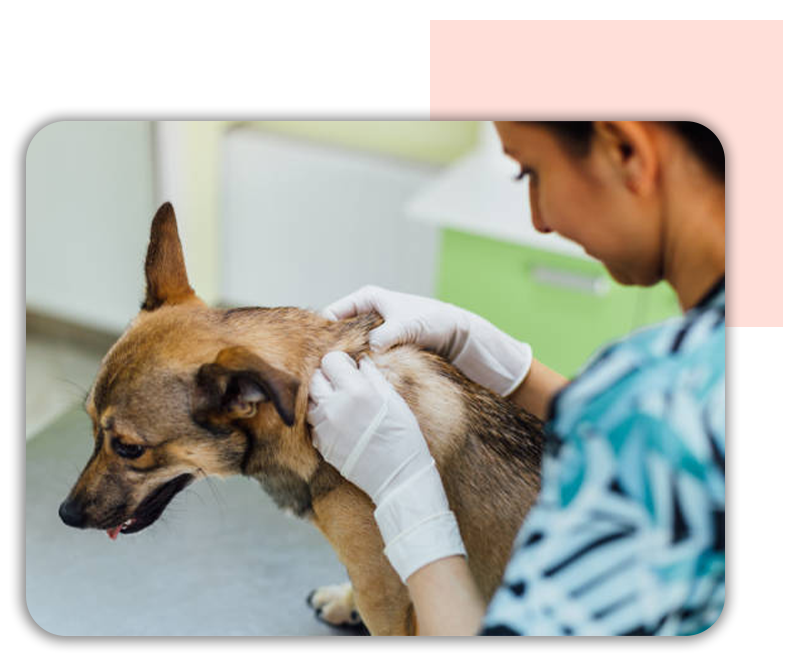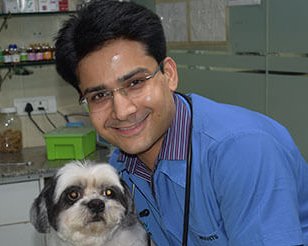This branch deals with the study, treatment and diseases of the skin. Skin disease is a very common and frequently occurring problem in dogs and cats.
Due to the pet’s fur coat, it is not always easy to notice when the pet has a skin condition. But common observable signs which can tell this include:
- Constant licking
- Scratching at affected areas
- Dandruff accumulation in the fur
- Redness
- Unpleasant odor
- Fear of touch
- Avoiding baths severely
Chewing feet constantly

Diagnosing a skin problem may simply require an examination and skin scraping by a veterinarian. However, most of the skin problems require additional steps to accurately obtain a diagnosis.
Additional diagnostic procedures may include:
- Skin scraping
- Ear swab
- Cytology
- Culture and sensitivity
- Stains
- Endocrine testing
- Blood work
- Urinalysis
- Punch biopsies
- Serum allergy testing
- Desensitization therapy
Elimination feeding trials, etc.
The cause of skin problems may range from hormonal disorders to common flea. Although the most common cause is allergies. Other causes include infections, bug bites, etc.
- Ear mites:
- The most commonly seen species is Otodectes cynotis.
- It is responsible for 90% of the ear mite infections in cats.
- It is highly contagious and can be easily spotted if the dog or the cat is found constantly scratching the ears.
- Atopic dermatitis:
- It is an inflammatory, chronic skin disease associated with allergies.
- It is the second most common allergic skin disease in dogs.
- The causes are mostly normal harmless substances such as grass, mold spores, house dust mites, etc.
- The signs include constant scratching, itching, rubbing and licking, especially around the face, paws, and underarms.
- Hair loss (alopecia):
- It is a common disorder in companion animals especially dogs.
- It can affect the pet’s skin, its endocrine system, its lymphatic system and its immune system.
- It can be gradual or acute.
- It is extremely noticeable and the patient also exhibits scaling of the skin.
- The causes are various from abnormalities to allergies and the treatment options are chosen according to the cause.
- Ringworm:
- Classical symptoms include lesions appearing on the pet’s head, ears, paws, and forelimbs and hair loss.
- Causes include malnourishment, immunocompromisation, stress, infection, etc.
- It is contagious and treatment depends on the severity of the infection.
- Flea allergy dermatitis:
- It is the most common skin disease in pets.
- The saliva of the flea is believed to be the actual cause of the hypersensitivity.
- Symptoms include itching, scratching, hair loss and scabs and are often episodic.
- Demodectic mange:
- These are mites that are transmitted to puppies from their mother during the first few days of life.
- It is an inflammatory disease and non contagious.
- The symptoms may be localised or arbitrary and include alopecia, redness of the skin and the appearance of scales and lesions.
- Sarcoptic mange:
- It is a contagious, intensely itchy skin condition caused by a tiny, burrowing mite.
- Spreads by skin to skin contact.
- Alopecia is the most common symptom.
- Lick granulomas:
- It is most commonly found in dogs. As a result, the dog gets urged to lick the lower portion of one of his or her legs.
- Seborrhea (dandruff/greasy coat):
- It is a common disorder which causes the skin to flake and become oily or greay.
Treating a skin condition, especially if it happens to be ringworm or mange, takes patience and consistency.
- The most common treatment for ear mite in current use is antiparasitics like ivermectin and selamectin.
- Common treatments are:
- Apoquel (oral medication)
- Cytopoint (injectable)
- Diet change (if necessary)
- Antimicrobials
- Hormone treatment
Allergies cannot be fully cured, but their symptoms can be managed quite well with an effective treatment plan.
Meet our team members











